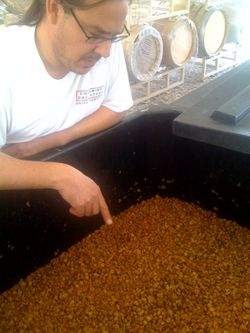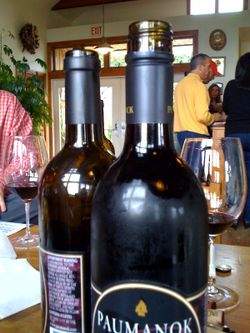By Evan Dawson, Finger Lakes Editor
Morgan and I took our first trip to Long Island wine country last weekend and I plan to share some observations and experiences in a series of upcoming posts. They are in no particular order of quality or chronology, and I should state emphatically that the winemakers and owners we met were excessively generous with their time and cellars.
Long Island wine country is, in no small measure, a must-visit for New York wine enthusiasts. It is wildly different when compared to the state's other appellations. The vineyards are flatter than a cookie sheet and gorgeously maintained, and there are unique stories and approaches to find in each stop.
Paumanok Vineyards is situated on the North Fork and Channing Daughters Winery lies in the Hamptons, but there is a common theme to be discovered at each — experimentation is yielding some fascinating results.
We tasted 22 wines at Channing Daughters, where winemaker Chris Tracy seems to take particular delight in unveiling the menagerie of bottlings.
Do you like chardonnay? They have, in some form or another, six of them. There are three roses. You can find pinot grigio, and you can also find a richer, copper-colored version with the body of a supermodel. But for me, the most interesting and enjoyable experiment comes with Tocai Friulano, which shows up in a handful of Tracy's bottlings.
Tocai is an experiment that only Channing has seen fit to make on the island. "We don't view our land as only suitable for merlot, or only suitable for sauvignon blanc," Tracy says, smiling. "We have similarities to a range of wine regions like Friuli, but of course we're ultimately our own place. And we've found that tocai can make some wonderful, fresh wines here."
Fresh is the word. These wines, designed to drink young, are aromatically dynamite. Tracy uses tocai to add characteristics that are unique on Long Island. A cynical customer might think there are a variety of blends because it allows Channing to sell more wine. To some degree that must be true — a wine geek would positively salivate at the idea of buying a horizontal of varyingly styled chardonnays or pinot prigios. But any cynicism should fade when the customer hears Tracy explain the reason for each blend. Tracy is intensely thoughtful, and tasting with him is a hell of a lot of fun.
I didn't love each wine, but I appreciated his reasoning. 
Up at Paumanok, winemaker Karim Massoud is making one of my favorite red wines in New York state: a straight petit verdot. He's only made it twice, in 2005 and 2007, and he only plans to make it in standout vintages. The variety is otherwise a nice blending grape, but I thought it was distinctive on its own.
"Petit verdot has smaller berries, so it naturally provides more tannin, color and acid," Massoud told us over lunch in the tasting room. "We're excited to see what it does on its own, but it's still difficult to judge. Even the 2005 is a young wine."
He's right. The 2007 still strips some enamel and the '05 is big and rough with tannins. My bottle will have a long time to mellow before I open it. Even now, though, it's clear that the Paumanok petit verdot will offer a unique profile when compared to the merlots and cabernet francs that dominate the region.
They're even experimenting with closures at Paumanok.
You can see in the picture that the '07 Merlots are divided between natural cork and screw cap. Massoud suspects the screw capped wines will age gracefully, but at some point they'll have a perfect opportunity to test the closures side by side.
I'm thrilled with the idea of exploring new varieties in this state.
Certainly we're seeing that cabernet franc can shine across New York wine regions, and I'd even argue that in the small sample size of what is produced, blaufrankisch has a bright future. But each piece of land offers different possibilities.
The Finger Lakes growers are wise to experiment with varieties like gruner veltliner and zweigelt, while Long Island growers are making strides with petit verdot and even tocai in the Hamptons. Merlot and riesling will always be there. Now we're finding out what else will join the viticultural party.
